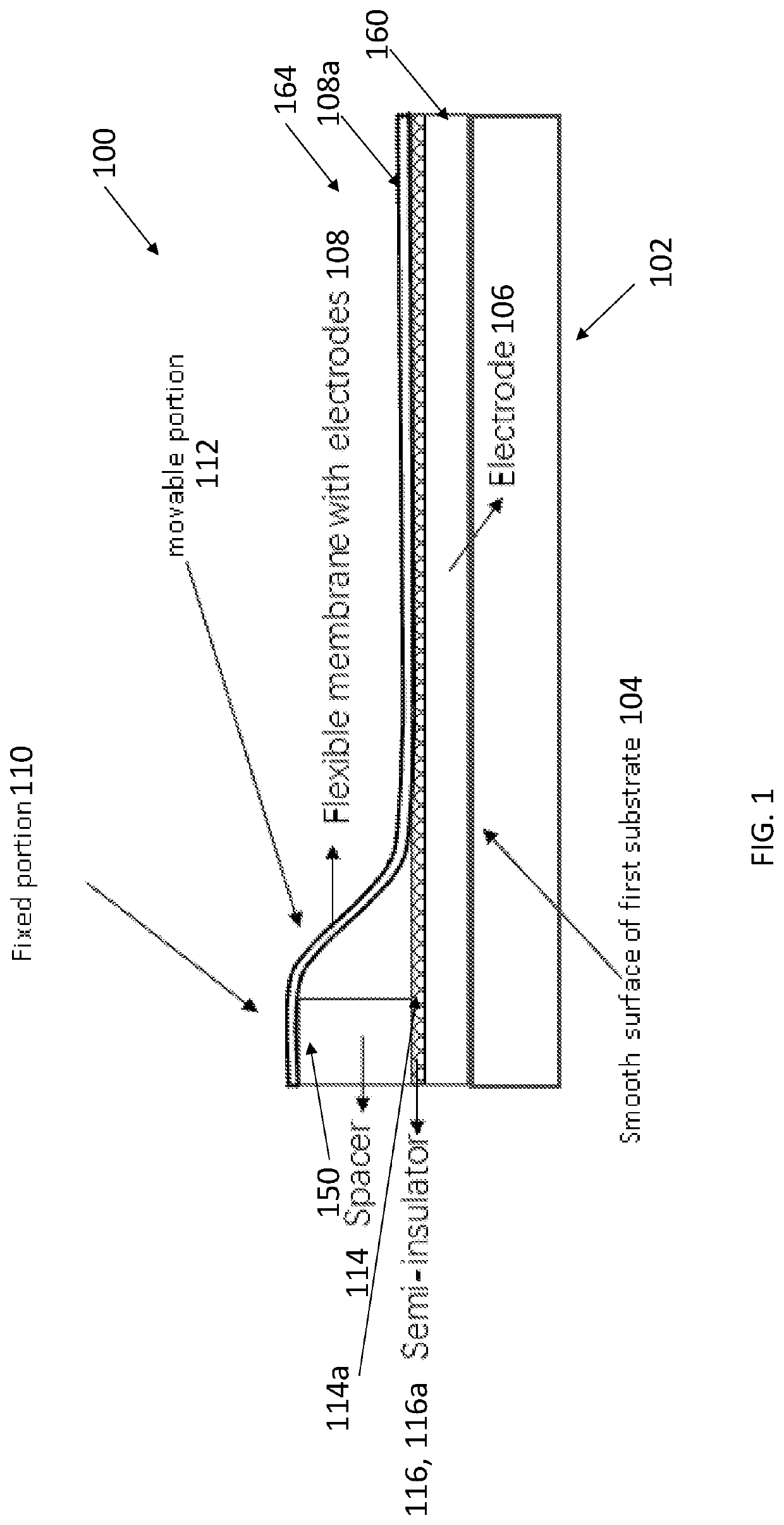Electrostatically actuated device
- Summary
- Abstract
- Description
- Claims
- Application Information
AI Technical Summary
Benefits of technology
Problems solved by technology
Method used
Image
Examples
first example
Structure
[0047]FIG. 1 illustrates an actuator device 100 driven by electrostatic forces, comprising a substrate 102 including and / or defining a smooth surface 104; a layer comprising a substrate electrode 106 on the smooth surface of the substrate; and a flexible membrane 108 overlaying the substrate electrode. The flexible membrane 108 includes a flexible electrode 108c (or flexible electrode layer 108a); a fixed portion 110; and a movable portion 112. The fixed portion is attached to an underlying surface 114a (e.g., a spacer 114) of the substrate or to a spacer 114 between the substrate 102 and the fixed portion 110. The movable portion 112 is movable with respect to the substrate electrode 106. FIG. 1 further illustrates a semi-insulator 116 (or layer 116a comprising a semi-insulator) separating the substrate electrode 106 from the flexible electrode or flexible electrode layer 108a. In one or more examples, the semi-insulator 116 is on or above the substrate electrode 106. In o...
second example
Structure
[0048]FIG. 2 illustrates an actuator device 200 driven by electrostatic forces having the structure of FIG. 2 but also further comprising a second substrate 202 (having and / or defining a second smooth surface 204); and a second layer comprising a second substrate electrode 206 on the second smooth surface of the second substrate, so that the flexible membrane 108 overlays the first substrate electrode 106 or the second substrate electrode 206 depending on the voltage differential being applied between the flexible electrode and the flexible electrode layer and the substrate electrodes. FIG. 2 further illustrates the flexible membrane further includes a second fixed portion 208 (attached to an underlying surface 208a of the second substrate or to a second spacer 210 between the second substrate and the second fixed portion). The movable portion 112 is movable with respect to the first substrate electrode 106 and the second substrate electrode 206. A second semi-insulator 212...
third example
Structure (Cooling Device)
[0049]FIG. 3 illustrates an electrostatically actuated electrocaloric cooling device 300, comprising a first substrate 302 defining or having a smooth surface 304; a first substrate electrode 306 forming a layer, or a layer 306a comprising an electrode 306, on the smooth surface of the first substrate; a second substrate 308 defining or having a smooth surface 310; and a second substrate electrode 312 forming a layer (or a layer 312a comprising an electrode 312) on the smooth surface 310 of the second substrate.
[0050]The device further includes a (e.g., two-layer) flexible electrocaloric (e.g., polymer) stack 314 including one or more polymer layers 314b and one or more (e.g., three) flexible electrode layers 314a, fixed portions 316a, 316b attached to an underlying surface of the first substrate and the second substrate, respectively, and a movable portion 318 that is movable with respect to the first substrate electrode and the second substrate electrode....
PUM
 Login to View More
Login to View More Abstract
Description
Claims
Application Information
 Login to View More
Login to View More - R&D
- Intellectual Property
- Life Sciences
- Materials
- Tech Scout
- Unparalleled Data Quality
- Higher Quality Content
- 60% Fewer Hallucinations
Browse by: Latest US Patents, China's latest patents, Technical Efficacy Thesaurus, Application Domain, Technology Topic, Popular Technical Reports.
© 2025 PatSnap. All rights reserved.Legal|Privacy policy|Modern Slavery Act Transparency Statement|Sitemap|About US| Contact US: help@patsnap.com



